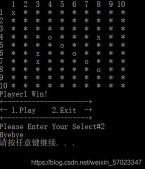Linux下c实现的数据库备份,只要修改数据库列表文件的信息即可。
db_list.txt把后缀去掉即可,一个数据库一行。
1. main.c
|
1
2
3
4
5
6
7
8
9
10
11
12
13
14
15
16
17
18
19
20
21
22
23
24
25
26
27
28
29
30
31
32
33
34
35
36
37
38
39
40
41
42
43
44
45
46
47
48
49
50
51
52
53
54
55
56
57
58
59
60
61
62
63
64
65
66
67
68
69
70
71
72
73
74
75
76
77
78
79
80
81
82
83
84
85
86
87
88
89
90
91
92
93
94
95
96
97
98
99
100
101
102
103
104
105
106
107
108
109
110
111
112
113
|
#include<sys/types.h>#include<sys/wait.h>#include<ctype.h>#include<unistd.h>#include<string.h>#include<stdlib.h>#include<stdio.h> //待备份的数据表文件(一个数据库一行)#define DB_FILE "./db_list"//最多可以备份的数据库数量#define NUM 20//一个数据库名字的最长字符数#define LEN 128//保存从DB_FILE中读取到的数据库char *db_list[NUM];//从DB_FILE文件中读取到的数据库数量int read_num;//请求内存函数void malloc_dblist();//释放内存函数void free_dblist();//读取数据库文件void readDbFile(); int main(int argc, char *argv[]) { pid_t pid; int i; char buf[LEN]; //从文件读取数据库信息 readDbFile(); pid = fork(); if (pid < 0) { fprintf(stderr, "fork error\n"); exit(1); } switch (pid) { case -1: fprintf(stderr, "fork failed\n"); exit(1); case 0: //子进程进行数据库的备份 for (i = 0; i < read_num; i++) { memset(buf, '\0', LEN); sprintf(buf, "%s%s%s%s%s", "mysqldump -uroot ", db_list[i], " > ", db_list[i], ".sql"); system(buf); printf("%d,%s\n", i, buf); } break; } //等待子进程的结束 if (pid > 0) { int stat_val; pid_t child_pid; child_pid = wait(&stat_val); if (!WIFEXITED(stat_val)) { fprintf(stdout, "Child terminated abnormaly\n"); } exit(1); } free_dblist(); exit(0); } void malloc_dblist(){ int i = 0; //malloc for db_list for (i = 0; i < NUM; i++) { db_list[i] = malloc(LEN); memset(db_list[i], '\0', LEN); }}void free_dblist(){ int i; //free db_list's memory for (i = 0; i < NUM; i++) { free(db_list[i]); }} void readDbFile(){ FILE *fp; fp = fopen(DB_FILE, "r"); if (!fp) { fprintf(stderr, "%s not found\n", DB_FILE); } else { malloc_dblist(); read_num = 0; while (fscanf(fp, "%127[^\r\n]\n", db_list[read_num]) == 1) { puts(db_list[read_num]); read_num++; } fclose(fp); } } |
2. db_list.txt
|
1
2
|
adminbook |
3.
|
1
2
3
4
5
6
7
8
9
10
11
12
13
14
15
16
17
18
19
20
21
22
23
24
25
26
27
28
29
30
31
32
33
34
35
36
37
38
39
40
41
42
43
44
45
46
47
48
49
50
51
52
53
54
55
56
57
58
59
60
61
62
63
64
65
66
67
68
69
70
71
72
73
74
75
76
77
78
79
80
81
82
83
84
85
86
87
88
89
90
91
92
93
94
95
96
97
98
99
100
101
102
103
104
105
106
107
108
109
110
111
112
113
|
#include<sys/types.h>#include<sys/wait.h>#include<ctype.h>#include<unistd.h>#include<string.h>#include<stdlib.h>#include<stdio.h> //待备份的数据表文件(一个数据库一行)#define DB_FILE "./db_list"//最多可以备份的数据库数量#define NUM 20//一个数据库名字的最长字符数#define LEN 128//保存从DB_FILE中读取到的数据库char *db_list[NUM];//从DB_FILE文件中读取到的数据库数量int read_num;//请求内存函数void malloc_dblist();//释放内存函数void free_dblist();//读取数据库文件void readDbFile(); int main(int argc, char *argv[]) { pid_t pid; int i; char buf[LEN]; //从文件读取数据库信息 readDbFile(); pid = fork(); if (pid < 0) { fprintf(stderr, "fork error\n"); exit(1); } switch (pid) { case -1: fprintf(stderr, "fork failed\n"); exit(1); case 0: //子进程进行数据库的备份 for (i = 0; i < read_num; i++) { memset(buf, '\0', LEN); sprintf(buf, "%s%s%s%s%s", "mysqldump -uroot ", db_list[i], " > ", db_list[i], ".sql"); system(buf); printf("%d,%s\n", i, buf); } break; } //等待子进程的结束 if (pid > 0) { int stat_val; pid_t child_pid; child_pid = wait(&stat_val); if (!WIFEXITED(stat_val)) { fprintf(stdout, "Child terminated abnormaly\n"); } exit(1); } free_dblist(); exit(0); } void malloc_dblist(){ int i = 0; //malloc for db_list for (i = 0; i < NUM; i++) { db_list[i] = malloc(LEN); memset(db_list[i], '\0', LEN); }}void free_dblist(){ int i; //free db_list's memory for (i = 0; i < NUM; i++) { free(db_list[i]); }} void readDbFile(){ FILE *fp; fp = fopen(DB_FILE, "r"); if (!fp) { fprintf(stderr, "%s not found\n", DB_FILE); } else { malloc_dblist(); read_num = 0; while (fscanf(fp, "%127[^\r\n]\n", db_list[read_num]) == 1) { puts(db_list[read_num]); read_num++; } fclose(fp); } } |
以上所述就是本文的全部内容了,希望大家能够喜欢。















